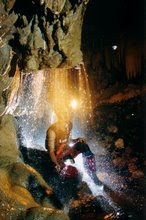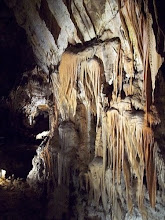The most important fieldtrip and
National Karst Workshop were
performed at the south Gombong
karst in 2002, by the local
government of Kebumen. The
recent head of state is a very
intelligent lady scientist, who
perceived the importance of karst
and who was depressed to observe
how fast this scenic south
Gombong karst dwindles, due to
unlimited blasting and illegal
limestone quarrying by the local
inhabitants and immigrants, to
supply the 137 kilns, that also
require so much wood to be
burned, thereby deforesting the
whole karst area, which actually
produce highly priced teak. Wood
is being supplied from surrounding
non karst areas, some of which
turned out to be illegally logged.
Unsightly open quarries and karst
landscape destruction plus heavy
air pollution are the result, the
hamlets of Redisari and Kalisari
being the most affected. Not a
single day, even not a single hour is
there fresh air. Smoke and dust are
everywhere, even darkening the
daylight environment, especially
after some kilns use coal instead of
wood, thereby producing a nasty
scent.
home made palm sugar,
requiring again, much wood.
Former lucrative but labour
intensive farming was
abandoned. The locals prefer
quick yielding limestone
quarrying. Butcontroversially,no one
became rich. The locals only got Rp 15,000,- a day for
blasting, quarrying and carrying the limestone
chunks to the kilns. Kilnowners only got a profit of at
most Rp 150,000 a week,since they must pay so much
for firewood or coal Inhabitants of both hamlets still
remember nostalgically the fresh
air and bright days when no kilns
were known. Water was abundant
even in the driest season.
Nowadays some spring wells are
dry in the dry season and the big
springs produce less water than
formerly. On the other hand, flood
in the plains surrounding the karst
hills, especially on the eastern part
during heavy rain, is the rule rather
than an exception, completely
inundating the main road to the
village of Puring, creating a vast
lake for days Landslides have
happened on the western and
southeastern part of this karst area,
destroying houses and killing some
inhabitants.
Some hunters are still active killing
the few monkeys left in the sparse
forest above the Petruk Cave.
Som"enirs and handicraft are sold
by locals, benefiting from the
Jatijajar Cave tourism site. A few
eating stalls near the Jatijajar,
Petruk and Karangbolong caves are
owned by locals, but many more
by immigrants. The holy Sendang Pelus spring
well is rarely visited by tourists.
Rice planting on the fertile alluvial
plain surrounding the karst hills
produces good crops. Many fruit
bearing trees are abundantly
producing.
Many karst areas in Indonesia
impose identical or similar
problems. Those are short term
exploitation (mining) versus long
term sustained utilization (tourism,
farming or husbandry).
The ultimate fate of Indonesian
karst environment is in the hands
of the local inhabitants and more
important, under
the jurisdiction of the local head of
government.
However,neither side are
usually aware of the importance of
this unique and valuable nature
resource. Even the central
government, the parliament, the
Policy and decision makers, the
bureaucrats, the scientists, the
educators, the students and
professors, members of non
government organizations, are not
equally aware of the global importance of karst, with emphase
on water and biodiversity of karst
terrains. Only a very few have ever
heard about the concept of karst
being an dynamic energy system,
with water as the driving force.
"Man in karst", an international
issue, the most important and
valuable or destructive element,
upon which the ultimate fate of
karst depends, is not yet
highlighted in Indonesia.
The most feasible proposed
solution, is thus the education of
man in karst, to instill awareness of
the importance of karst. This
requires nationwide, professionally
prepared strategies and performed
all out on several levels
concomitantly, as pioneered by
FINSPAC. that has in the past
organized technical caving and
scientific speleological courses for
university students, educational
lectures and fieldtrips for
elementary and high school
students and for scientists,
scientific symposia, panel
discussions, and workshops on
karst and caves, attended by
bureaucrats, educators and
scientists as well, lobbying high
standing bureaucrats and
policy makers up to the level of
ministers, recruiting senior
government officials as active
FINSPAC members or advisors,
thereby creating the strong image
that FINSPAC is not opposing the
government but functions as active
and constructive partner.
Many more "man in karst based
organizations" should be created,
as pioneered and facilitated by the
Kebumen Government.
Local inhabitants, university
graduates, have been and are being
recruited to identify all possible
ways to solve existing karst
environment problems. They are
encouraged to maintain a
constructive dialogue with all
stakeholders and government
officials. Their need to improve
living conditions are discussed
periodically, constructively and
transparently with the Keburnen
government and Kebumen
parliament members on an equal
base. All local educated people are
now aware of the strategic values
of South Gombong karst.
Alternative solutions to utilize this
important and unique karst formation in a sustainable way are
scrutinized with the assistance of
FINSPAC's scientists.
Lucrative Koi breeding outside
spring wells, mushroom cultivation
in certain humid caves, and
replantation of barren karst terrains
with ground co'.ers and edible
shrubs for goat I-treeding are short
term solutions. So is the use of
compacted sawdust in special
containers, functioning as efficient
ovens for daily cooking and palm
sugar production.
Cultivating edible and medicinal
plants are middle term programs.
So are breeding of goats, sheep,
rabbits in enclosures. Duck
breeding, so popular in Kebumen's
neighboring districts supplying
restaurants serving roasted duck satay, and curry should be
introduced.
Longterm programs are being
concocted with the aid of
Professor Suhardi and the Karst
Forest Research Center of the
Gajah Mada University (Wana
Gama). Planting the very
expensive Gaharu and Sandalwood
trees is on the list. So is the
building of swiftlets houses,
producing edible nest outrageously
expensive.The official symbol of Kebumen is
actually cave swiftlets, so well
known, occupying some sea caves
on the southern part.
Unfortunately, due to robbery,
mismanagement and deteriorating
environment, the number of cave
dwelling swiftlets is decreasing
alarmingly. Cave and karst tourism
is also on the long term list.
Management of Jatijajar and
Petruk caves is bad, not in the least
reflecting the international
standard of tourist cave
management. The urgent need to
develop Petruk cave as a national
sample for tourist cave
management is frequently
pronounced by FINSPAC.
All plans have no meaning if not
lffiplemented. To implement them.
funds are needed. This is then the
biggest dilemma in Kebumen. All
sensible recommendations put
down on paper on the last day of
the national Workshop on South
Gombong karst still remain on
paper. It is therefore mandatory
that all kinds of recommendations
should be backed up by available
funds, enabling the
Implementation of all programs
concocted.
The government of Kebumen is
however convinced, that deyeloping its karst region must
never be restricted to that region
only. The surrounding non-karst
Kebumen regions should be deyeloped
concomitantly, thereby decreasing
the pressure on the karst
environment. Any and all efforts to create jobs
outside the karst region should be
attempted. It is a great blessing that
Kebumen has so many
opportunities
to develop
surrounding non-karst areas to
create jobs.Number one on the list is to boost
tourism at the Ijo river delta. An
integrated plan to develop tourism
at the scenic coastal area and
meandering river, can potentially
overshadow even the well-known
but nowadays deteriorating touristic Pangandaran resort The alternative road, connecting
Yogyakarta to Cilacap, via the
panoramic southern coast, ought to
be considered a golden opportunity
to develop tourism alongside it.
Fishing, canooing, para sailing,
swimming, surfing, water skiing,
sailing, trekking in the very scenic
surrounding hilly area, caving, sky
diving, rock climbing on the
precipitous coastal hill - side, and
ecotourism, are no fatamorgana but
real opportunities, luring domestic
and foreign investors.
Local inhabitants should be trained
in providing facilities on a --bed
and breakfast" basis, as already
done by FINSPAC's president,
who took time to teach five
guesthouse owneers in the hamlet
near Petruk cave.to cook simple
meals, internationally known, like
French bread, spaghetti. fried rice,
goulash, chop suey .But it is mandatory for the
Kebumen government to finish and
publish the environment spatial and
purpose planning, as prerequisite
for creating a data base for
Keburnen and the Geographic
Information System









